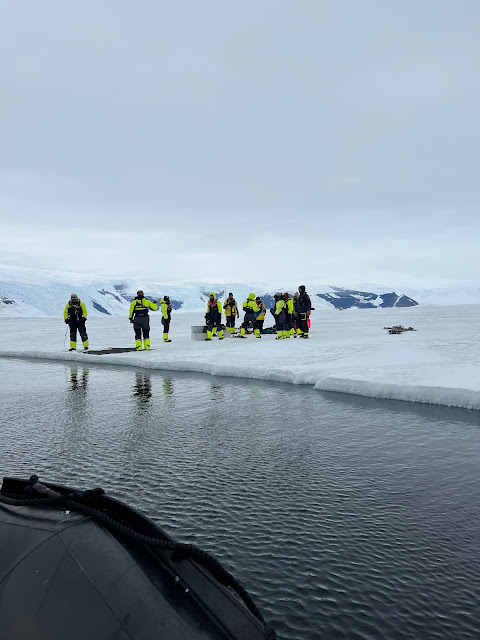 |
| Scott’s Hut |
[I’m beginning to think that I am all out of sync with the dates – blame the International Dateline plus the dates on the program and confusion with dates on my phone … and other things. The sequence of events is OK.]
This morning, whichever date, most of the ice around Cape Evans had blown away and we were set to make a landing. The site was as I remember it – it is cared for meticulously by the New Zealand Antarctic Heritage Trust. We split into groups – some went to the hut and others went walking and then we switched.
Before entering the hut (built in 1911 as part of the British Antarctic Expedition of 1910–1913) we had to remove our boots and only a couple of people were allowed in at a time. It was quite eerie standing in the space where 112 years ago men had toiled at all manner of things to keep going and to made life bearable. (I have included a collage of photos of the hut dating back to that expedition, the expedition from which Scott tragically never returned).
"It is a time warp without parallel. You walk into Scott's hut and you are transported to the year 1912 in a way that is quite impossible anywhere else in the world." Sir David Attenborough.
 |
These photos date back to the Cape Evans hut (Terra Nova expedition 1910–1913)
|
 |
| These photos taken by 'yours truly' |
Outside the ground was littered with bits and pieces of material, timber, nails, wire, crates. Everything had to be left in its place. It as quite an experience to be there but Lindsay and I felt disappointed that we had not been able to visit the Discovery Hut from Scott's first expedition, the Discovery Expedition of 1901–1904.
That afternoon we retraced our steps to visit Cape Royds where Shackleton’s hut from his 1907-09 expedition still stands. I was excited about the prospects of a visit as I hadn’t been ashore on our the last voyage to Antarctica in 2020. Our Captain looked for a place to let down the anchor but didn’t find any that he was happy with. Strangely two other ships in the area managed to visit! He decided to drop anchor nearby and try again in the morning. Come morning, again he was not happy with the location – too much ice (a very conservative captain).
 |
| The wind picked up a little funnelling down from the ice plateau |
 |
| The decks had heaters built in to melt the ice and snow |
We had been promised Terra Nova Bay and a sighting the stunning Drygalski Ice Tongue which stretches 70 Km out to sea. It is at least 4,000 years old. Not far from there is Inexpressible Island where Scott’s north party were marooned for 200-odd days living in an ice cave. The men suffered frostbite, hunger, and dysentery. The ship doctor George Murray Levick said:
"The road to hell might be paved with good intentions, but it seemed probable that hell itself would be paved something after the style of Inexpressible Island."
Such places are special but we simply didn’t get there and there was no explanation why we didn't. Instead we headed for Coulman Island, an ice-covered island made up of volcanoes. The weather wasn’t brilliant (this is Antarctica) and there was no place to land or even launch the zodiacs so we moved on. I realise that weather plays a huge part in determining destinations but in spite of their very special navigation aid – a helicopter and depth finder vessel! we seemed to wander aimlessly. A dreadful waste of time given the extraordinary coastline and islands in the Ross Sea.
 |
| Coulman Island with the Transantarctic Range behind |
In the meantime the Executive Chef, Florent Delfortrie, put on a cooking class on preparing Arctic Char (trout-like fish) – delicious.
























































